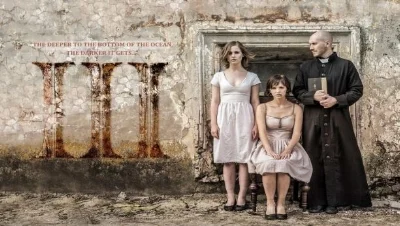Back in 2016, I reviewed a little anthology here by Witching Season FIlms. Michael Ballif and the team give a nostalgic nod to the halloween season by creating shorts of different genres and delighting fans with top-notch stories and editing. At the time of writing, there are five episodes available to peruse and enjoy, with rumors of a second season to come.
Ballif introduced his first feature, They Live Inside Us, this year - a full version of a previous award-winning short of the same name. The story follows a writer, Jake (James Morris), and his daughter Dani (Emily Broschinsky), who spend the night in a rumored-to-be haunted house to inspire lost creativity. The two are recovering from tragedy, and what better way to heal wounds than by opening dark, new, terrifying ones?
The film contains its own anthology of sorts while Jake spends his time trying to perfect his own story. He turns to a list of horror movie monsters and employs them in various stylized, vintage-esque vignettes throughout the film. Here we see the unnamed woman (Hailey Nebeker) running from the masked killer, haunted by the scarecrow, or followed by an unsettlingly effective evil clown. Morris really shines here as Choppy the Clown; not only does he play Jake, but each of the monsters, in turn. Wherever he might stumble in dialogue, he more than makes up for with facial expression. Also of note is the introduction of Broschinsky, who somehow steals each scene she’s in.
While definitely a slow burn, the film’s pacing never seems to suffer due to satisfying scares and atmosphere. Ballif’s greatest strength is his eye for detail and set design. Despite its more predictable turns, there is a kind of polish to the design one doesn’t expect from first time feature filmmakers. Another great feature is the sound and music, which adds greatly to the ongoing sense of dread and confusion the film employs.
Between Jake’s story, the real-life horror for him and Dani only grows. What is behind the locked door in the kitchen? What about the gurgling sounds coming from the bathroom? What really happened in this house, and what memories are still haunting it? As the night goes on, more questions than answers reveal themselves until the climactic conclusion.
Much like the original anthology, They Live Inside Us is full of nods to horror classics and familiar, comforting (for the freak in all of us) tropes. It’s easy to tell that everyone involved really loves horror, and loves working together to make something tangible out of that love and admiration for the genre. With an earnest effort given, They Live Inside Us is a promising start for what I hope is a long, burgeoning career for those involved.
They Live Inside Us is available to watch on iTunes/Apple TV, Amazon, VUDU, Google Play, Microsoft (XBox), Redbox on Demand, Vimeo, and Youtube Premium.











